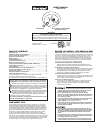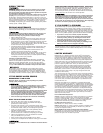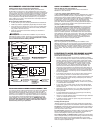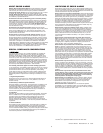
RECOMMENDED LOCATIONS FOR SMOKE ALARMS
Installing Smoke Alarms in Single-Family Residences
The National Fire Protection Association (NFPA), recommends one
Smoke Alarm on every floor
, in every sleeping area, and in every bed-
r
oom. In new construction, the Smoke Alarms must be AC powered and
interconnected. See “Agency Placement Recommendations” for details.
For additional coverage, it is r
ecommended that you install a Smoke
Alarm in all r
ooms, halls, storage areas, finished attics, and basements,
where temperatures normally remain between 40˚ F (4˚ C) and 100˚ F
(38˚ C). Make sur
e no door or other obstruction could keep smoke from
r
eaching the Smoke Alarms.
Mor
e specifically, install Smoke Alarms:
•
On every level of your home, including finished attics and basements.
•
Inside every bedroom, especially if people sleep with doors closed.
• In the hall near every sleeping area. If your home has multiple sleep-
ing ar
eas, install a unit in each. If a hall is over 40 feet (12 meters)
long, install an alarm at each end.
•
At the top of the first-to-second floor stairway, and at bottom of
basement stairway.
Specific requirements for Smoke Alarm installation vary from state to
state and fr
om region to region. Check with your local Fire Department
for curr
ent requirements in your area.
It is r
ecommended AC or AC/DC
units be interconnected for added protection.
4
BEDROOM
BEDROOM
HALL
L
IVING ROOM KITCHEN
FINISHED BASEMENT
REQUIRED TO MEET
NFPA RECOMMENDATIONS
RECOMMENDED FOR
ADDITIONAL PROTECTION
BEDROOM
BEDROOM
K
ITCHEN
L
IVING ROOM
DINING ROOM
MULTI-STORY RESIDENCE
SINGLE-STORY RESIDENCE, APARTMENT,
MOBILE HOME
KEY:
EXISTING HOMES
SMOKE ALARMS WITH SILENCE
FEATURES RECOMMENDED FOR
ADDITIONAL PROTECTION
BEDROOM
BEDROOM
HALL
LIVING ROOM KITCHEN
F
INISHED BASEMENT
BEDROOM
BEDROOM
LIVING ROOM
DINING ROOM
MULTI-STORY RESIDENCE
SINGLE-STORY RESIDENCE, APARTMENT,
MOBILE HOME
EXISTING HOMES
KITCHEN
REQUIRED TO
MEE
T NFPA
RECOMMENDATIONS
RECOMMENDED
FOR ADDITIONAL
P
ROTECTION
KEY:
SMOKE ALARMS WITH SILENCE
FEATURES RECOMMENDED FOR
ADDITIONAL PROTECTION
INTERCONNECTED AC OR
AC/DC SMOKE ALARMS
BEDROOM
BEDROOM
HALL
LIVING ROOM KITCHEN
FINISHED BASEMENT
REQUIRED TO MEET
NFPA RECOMMENDATIONS
RECOMMENDED FOR
ADDITIONAL PROTECTION
BEDROOM
BEDROOM
LIVING ROOM
DINING ROOM
MULTI -STORY RESIDENCE
SINGLE-STORY RESIDENCE, APARTMENT,
MOBILE HOME
KEY:
NEW CONSTRUCTION
SMOKE ALARMS WITH SILENCE
FEATURES RECOMMENDED FOR
ADDITIONAL PROTECTION
KITCHEN
INTERCONNECTED
AC OR AC/DC
SMOKE ALARMS
BEDROOM
BEDROOM
HALL
LIVING ROOM KITCHEN
FINISHED BASEMENT
REQUIRED TO
MEET NFPA
RECOMMENDATIONS
RECOMMENDED
FOR ADDITIONAL
PROTECTION
BEDROOM
BEDROOM
LIVING ROOM
DINING ROOM
MULTI -STORY RESIDENCE
SIN
GLE-STORY RESIDENCE, APARTMENT,
MOBILE HOME
KEY:
NEW CONSTRUCTION
SMOKE ALARMS
WITH SILENCE
FEATURES
RECOMMENDED
FOR ADDITIONAL
PROTECTION
KITCHEN
INST
ALLING SMOKE ALARMS IN MOBILE HOMES & R
VS
For minimum security install one Smoke Alarm as close to each sleeping
area as possible. For more security, put one unit in each room. Many
older mobile homes (especially those built before 1978) have little or no
insulation. If your mobile home is not well insulated, or if you are unsure
of the amount of insulation, it is important to install units on inside walls
only. Smoke Alarms should be installed where temperatures normally
remain between 40˚ F (4˚ C) and 100˚ F (38˚ C). WARNING: Test units
used in RVs after the vehicle has been in storage, before every trip,
and once a week while in use. Failur
e to test units used in R
Vs as
described may r
emove your pr
otection.
AGENCY PLACEMENT RECOMMENDA
TIONS
NFP
A 72 (National Fire Code) Chapter 11
“For your information, the National Fir
e Protection Association's
Standard 72, reads as follows:”
“11.5.1 One- and Two-Family Dwelling Units.”
“11.5.1.1 Smoke Detection.
Wher
e required by applicable laws, codes, or
standar
ds for the specified occupancy, approved single- and multiple-
station Smoke Alarms shall be installed as follows: (1) In all sleeping
r
ooms Exception: Smoke Alarms shall not be required in sleeping rooms
in existing one- and two-family dwelling units. (2) Outside of each
separate sleeping area, in immediate vicinity of the sleeping rooms.
(3) On each level of the dwelling unit, including basements Exception: In
existing one- and two family dwelling units, appr
oved Smoke Alarms
powered by batteries are permitted.”
“A.11.8.3 Ar
e More Smoke Alarms Desirable?
The r
equired number
of Smoke Alarms might not pr
ovide reliable early warning protection
for those areas separated by a door from the areas protected by the
r
equired Smoke Alarms. For this reason, it is recommended that the
householder consider the use of additional Smoke Alarms for those
areas for increased protection. The additional areas include the base-
ment, bedr
ooms, dining room, furnace room, utility room, and hallways
not pr
otected by the required Smoke Alarms. The installation of Smoke
Alarms in kitchens, attics (finished or unfinished), or garages is not
normally r
ecommended, as these locations occasionally experience
conditions that can r
esult in improper operation.”
Califor
nia State Fire Marshal (CSFM)
Early war
ning detection is best achieved by the installation of fire
detection equipment in all rooms and areas of the household as follows:
A Smoke Alarm installed in each separate sleeping ar
ea (in the vicinity,
but outside bedr
ooms), and Heat or Smoke Alarms in the living rooms,
dining rooms, bedrooms, kitchens, hallways, finished attics, furnace
r
ooms, closets, utility and storage rooms, basements, and attached
garages.
LOCATIONS TO AVOID FOR SMOKE ALARMS
For best performance, it is recommended you AVOID installing
Smoke Alarms in these areas:
• Where combustion particles are produced. Combustion particles
form when something burns. Areas to avoid include poorly ventilated
kitchens, garages, and furnace rooms. Keep units at least 20 feet
(6 meters) from the sources of combustion particles (stove, furnace,
water heater, space heater) if possible. In areas where a 20-foot
(6 meter) distance is not possible – in modular, mobile, or smaller
homes, for example – it is recommended the Smoke Alarm be
placed as far from these fuel-burning sources as possible. The
placement recommendations are intended to keep these Alarms at
a reasonable distance from a fuel-burning source, and thus reduce
“unwanted” alarms. Unwanted alarms can occur if a Smoke Alarm is
placed directly next to a fuel-burning source. Ventilate these areas
as much as possible.
• In air streams near kitchens. Air currents can draw cooking smoke
into the sensing chamber of a Smoke Alarm near the kitchen.
• In very damp, humid or steamy areas, or directly near bathrooms with
showers. Keep units at least 10 feet (3 meters) away from showers,
saunas, dishwashers, etc.
• Where the temperatures are regularly below 40˚ F (4˚ C) or above
100˚ F (38˚C), including unheated buildings, outdoor r
ooms, por
ches,
or unfinished attics or basements.
• In very dusty, dirty, or greasy areas. Do not install a Smoke Alarm
directly over the stove or range. Keep laundry room Smoke Alarms
fr
ee of dust or lint.
• Near fresh air vents, ceiling fans, or in very drafty areas. Drafts can
blow smoke away fr
om the unit, preventing it from reaching the
sensing chamber.
• In insect infested areas. Insects can clog openings to the sensing
chamber and cause unwanted alarms.
• Less than 12 inches (305mm) away from fluorescent lights. Electrical
“noise” can interfer
e with the sensor
.
• In “dead air” spaces. “Dead air” spaces may prevent smoke from
reaching the Smoke Alarm.
Avoiding Dead Air Spaces
“Dead air” spaces may prevent smoke from reaching the Smoke Alarm.
To avoid dead air spaces, follow the installation recommendations below.
On ceilings, install Smoke Alarms as close to the center of the ceiling as
possible. If this is not possible, install the Smoke Alarm at least 4 inches
(102 mm) fr
om the wall or cor
ner.
For wall mounting (if allowed by building codes), the top edge of Smoke
Alarms should be placed between 4 and 12 inches (102 and 305 mm)
from the wall/ceiling line, below typical “dead air” spaces.
On a peaked, gabled, or cathedral ceiling, install the first Smoke Alarm
within 3 feet (0.9 meters) of the peak of the ceiling, measured horizontally.
Additional Smoke Alarms may be required depending on the length,
angle, etc. of the ceiling's slope. Refer to NFPA 72 for details on require-
ments for sloped or peaked ceilings.







